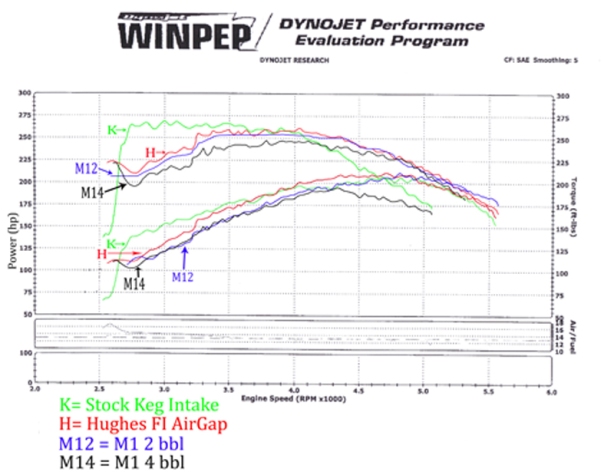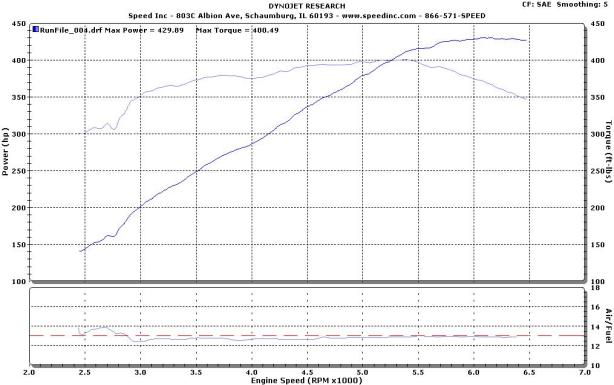It is hard to make horsepower in the magnum motors. The heads are the limiting factor, as well as the 9 to 1 compression block. They respond well with turbo or supercharger applications, but at a price. The problem is, the limitations in the heads have a near net effect with the application of boost. A supercharger on this truck will see gains of 125 hp with 6 psi, while that same setup on other motors can net 200 hp. Add to the problem the lack of detonation protection, inadequate cooling in the heads, and very little tuning availability, and that $5000 supercharger doesn’t look as good. Advertised claims of 60% rear-wheel horsepower (Procharger 1DB212-SCI) is such a small gain that the company doesn’t even show dyno graphs or provide actual HP numbers http://www.procharger.com/dodge.shtml. Vortech is the only other option, but they stopped making the kit, and results were similar. It doesn’t matter how you provide the pressure, limited flow in the heads correlates to minimal increases in volumetric efficiency.
Here is a sample of a “tuned” truck. The article from delmarvadodge.com “Dodge Magnum Intake Shootout”., describes this truck as “mildly warmed over”. Here is the actual engine specs.
360 bored .060 over
stock pistons/rods/crank
race balanced
compcam 206/208 .480/.512
iron ram heads 2.02 intake shaved .020
Hughes HD lifters
M1 intake
F&B 50mm TB
Summit truck headers
mini cat
flowmaster, dual outlets, side exhaust
24# ford injectors
An estimated cost of this engine and tuning, and all associated parts is probably $3000, and here is the graph that follows.

delmarvadodge.com “Dodge Magnum Intake Shootout”.
The green line represents the stock “kegger” intake manifold, with the other two being high performance M1 ($300) and Airgap manifolds ($600). The first thing to notice is that even with the highest flow “bang for the buck” iron ram heads, and exhaust, and cam, and injectors (which are way too large for this application), and high flow throttle body, the stock intake was outperforming the other intakes at 50 mph. It didn’t lag far behind throughout the run, relative to cost. The author of the article used a very unusual 50 mph start point, rather than the customary 2000 and up rpm range. It can be assumed that the stock intake was superior earlier in the speed run, knowing the characteristics of the stock intake (flows well in lower rpm range), leading to this unusual presentation. But even the highest peak HP in the study, occurring at 110 mph wheel speed, was nearly matched by the stock intake manifold at 115 mph. But the overall numbers are pathetic for a built V8 engine, barely rising above the stock 200 rwhp (est), that occurs in a much more useful range in the 1999-2004 Dakota RT.
Here is another test of the same 3 available manifolds for this motor, available at hughesengines.com

This test was performed on a totally stock motor with no tuning changes.
And this graph was obtained after changes by an SCT tuner ($400 plus $100 for each additional tune).

Hughesengines.com
The factory manifold had huge torque and superior hp in the driveable range to 4000 rpm of the first graph, and was nearly equal to the maximum “tuned” numbers of the airgap manifold, in this same range. The M1 was far inferior to both. But look at the overall numbers of the stock motor with factory intake and compare it to the $3000 motor in the previous test. We are only given rear wheel speed, but assuming 90 mph represents 3500 rpm, the range of 180-210 rwhp doesn’t give much support to the engine modifications. A gear change on this truck would be in order, but the cost would be $500-700 (why would you do this without replacing all of the bearings), and gas mileage and road noise would be much worse. Who wants to cruise at 2300 rpm?
And finally, here is a graph, again from delmarvadodge.com, showing a 408 Naturally aspirated engine, which would require tuning at the very least. Not much info is given about this motor, but the graph shows decent torque and hp. Once again, this graph begins at 60 mph this time, but give no indication of time to speed or rpm. It is anybody’s guess what performance is like, but 60 mph represents the ability to provide 225-250 hp with 325-350 tq. It is probably the best option of the three, if there is a reason to rebuild a stock engine, but this would represent at least a $4000 engine with entirely new rotating assembly, heads, and all associated hardware.

When accessing the dakotart.com forum, however, you are more likely to find guys saying this (Red comments added):
410, 10.3 comp pistons, P&P Eddies, 254 cam, 30lb injectors, sct tuner, 3800 viper stall, 4:56 yukon gears, hotchkis tvs, m1 4brrl, 58mm f&b tb, 1.7 rr, electric fan, jm longtube headers, B&M hammer shifter, Cope Racing Trans, Viper Brakes, SRT8 Seats, nx wet kit(100 shot) (not street driveable, costly), best time 11.32 @ 118 1.59 60′ on spray. 12.19@109 1.65 60′ n/a
Motor’s shot. R.I.P. 8/17/09. Rebuild in progress! (the problem with pushing these motors).
Forged 408 12.10 @ 111mph on a crappy tune and a stock fuel system except 30lb injectors (408hp and 418rwtq) looking for 430rwhp n/a with the upgraded fuel system and a better tune.) (Money pit).
So when considering a new motor for you dodge dakota or durango for performance, consider the downside of a 50-year-old platform.





